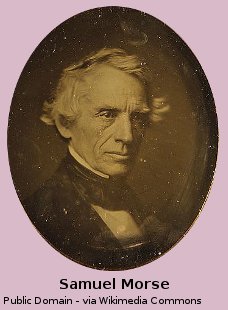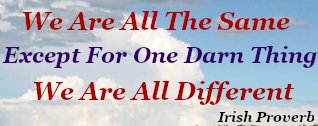A Closer Look At
Human Intelligence In Action
Part 18 - Part 17
Samuel Morse
Human intelligence is freely available to be drawn upon by each and every individual. but it's power can be dramatically increased when two or more minds blend in total harmony. Samuel Morse used this gift from Nature to great effect.
American born Morse (1791-1872) an accomplished Artist, was well known and recognized in Society for his artistic ability and engaging personality.
Following Cooke and Wheatstone, Morse, and Alfred Vale, were the second entity to commercialize their Electric Telegraphic Apparatus.
Samuel Morse's innovative declaration of a machine written recording of all messages transmitted, won the Public's Imagination. Widespread acceptance of his proposition introduced the Age of the Electric Telegraph.
The genesis of the means of Mass Communication.
Within the decade, Samuel Morse, and Morse Code, a system of Dots, Dashes, and Spaces representing letters of the Alphabet and Numerals, would be synonymous with Telegram. Morse Code would henceforth dominate the Electric Telegraphic Marketplace.
Keen Learner
Morse was in possession of a sure, innate, Desire to learn. An attribute of immeasurable value.
He demonstrated this deep desire by
qualifying for entry to Yale University at the early age of fourteen years.
At
Yale, Morse met friendly, influential professors, who took a personal
interest in him as
he immersed himself in studies of Art, Philosophy, Chemistry, and
Electricity, with equal passion. Art, with which Morse felt an intense
affinity, soon became his priority. It was this affinity he pursued as
an occupation, for the next several years, post Graduation.
During
his late thirties,
following a three year artistic tour in Europe, a period that proved to
be socially and artistically productive, but financially barren, Samuel
Morse recrossed the North Atlantic
Ocean to New York.
First Serious Musings
It was apparently
on this voyage that Morse had his first serious musings on his
Telegraph. Thinking big, he believed that not only could a signal be
sent over any distance, but that a permanent message could also be
transcribed.
After landing in New York, and settling down, Samuel
was fully occupied for the next several years. Much of it in isolation,
figuring out how to build his machine and make it work. Using his
lodgings, a single room, as a Workshop and Art Studio, he eked out a
subsistence selling his paintings.
Eventually, Morse was
recruited, by the then, infant, New York University, for the position of
Professor of Literature and Arts, where he met Leonard Gale and Alfred Vail (1807 -1859).
Leonard Gail and Alfred Vail proved to be an inventor's Dream Team. These intelligent Good Humans provided Samuel Morse, and his Telegraphic ambitions, with much needed support. Technical, Moral, and Financial.
Vail and Gale
Alfred Vail, a deeply moral man whose Passionate Dream to be a Presbyterian Minister was shattered by ill health, possessed a keen mechanical mind and demonstrated the ability to physically reproduce his ideas. Expressing a willingness to access his Human intelligence, Vail put these innate gifts to practical effect.
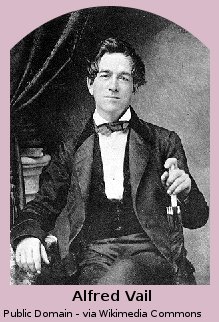
Leonard Gale, a Professor of Chemistry, was also familiar with the State
of the Art of the burgeoning Discipline of Electricity. Morse confided
his ambitions in Gale, and revealed to him, his working device he had
built from crude parts.
Displaying an intense interest in Morse's apparatus, Leonard noted it's shortcomings. Such as weak current supply
and an inability to transmit a signal over any great distance.
Acknowledging his awareness of these shortcomings, Morse's
solution was to insert Booster Relays at appropriate intervals along a given
route. Samuel expressed surprise when Leonard informed him that others involved in the Field of Electricity had come
to the same conclusion.
Samuel Morse was quite unaware that anyone else had conceived the idea of the Telegraph.
Gale
broadened Morse's knowledge, of what other's were doing in Telegraphy,
what advances had been made in Electricity, and what new hardware was
available.
Morse learnt about the work of Charles Wheatstone and
others, about Joseph Henry and his Electro-Magnet with it's finely wound
coil, and about the Daniell Cell that promised superior Current supply.
Grateful
to Leonard Gale, for the interest he expressed in his project, and the
enlightening, indispensable new knowledge now in his possession, Samuel
Morse approached his Electric Telegraph undertaking reinvigorated.
Fortune Smiles On Vail And Morse
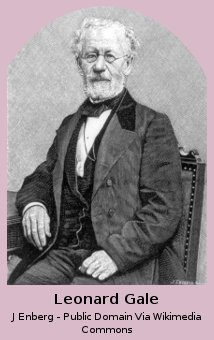
In a serendipitous course of events, Alfred Vail, after witnessing a prior exhibition of Morse's device, purposely visited him, uninvited, at Yale University, where Gale and Morse worked.
On this purposeful visit Vail ran smack bang into another demonstration. This time he observed Morse's apparatus, improved through the new knowledge imparted by Gale, working over a much longer distance.
Profoundly impressed, Alfred approached Morse after the demonstration.
His
sharp Mind vaguely grasping the Laws of Nature that allowed this
machine to work, and also recognizing the enormous benefits it offered
to the World, Vail inquired of Morse if he intended to pursue the
device's potential over even longer distances.
Morse replied in the affirmative, but first he would need to find a suitable investor to finance such a venture.
Reflection Is Intrinsic To Human Intelligence
Returning home, Vail relaxed, and reflected on the possibilities that the Electric Telegraph offered, and whether indeed it could be made to work over long distances.
Reflection is intrinsic to effective implementation of Human intelligence. As indicated here the actions taken by Alfred Vail, and his Father, are first class examples of the Potency contained within the phenomenon of Reflection.

Vail came to the same conclusion as did Morse himself. That if a
signal could be made to work over eight to ten miles then it could be
made to work over any other distance.
Deciding that the benefit to the World was indeed worth taking a risk, Alfred presented the
proposition of forming a partnership between himself and Morse, to
develop and commercialize the new Telegraphic System, to his Father.
Vail
senior, an astute businessman, demonstrating his practical Thinking
skills, instantly recognized the potential in funding his son's proposal. Subsequently, a contract
to form a Partnership between Samuel Morse and Alfred Vail was drawn
up.
With Leonard Gale and Alfred Vail working in Cooperation
with Samuel Morse, progress advanced rapidly to where proving Morse's
concept beyond doubt, a complete system needed to be installed and
tested under ambient conditions.
To achieve this necessary proof,
a copper wire Telegraph Line was constructed from Baltimore to
Washington DC. At the time, a distance of somewhere between fifty and
sixty kilometers.
Morse's Telegraph functioned as intended. Now,
the real work could begin. That of replicating this successful endeavor
beyond Washington, and on to the rest of the World.
Widespread Communication had been maneuvered onto a magnificent foundation by Human Intelligence.
True Understanding Invaluable
Twelve years in the making, from conception to creation,
Morse's baby was, like almost all jaw dropping undertakings, fraught
with obstacles that invite the less determined to give up.
When
any individual, or any combination of individuals, is determined to
overcome obstacles, a genuine, comprehensive, understanding of Human
Intelligence, is both indispensable and invaluable.
Seek and ye shall find, remains sound counsel, and is the only path to useful knowledge. The intellectual skills necessary to successfully execute this sound counsel are to be found in the realm of Personal Development. Otherwise known as Mind Expansion.
The implementation and rapid expansion of the Electric Telegraph is one more example of the effectiveness of Human action when individuals aspire to make the concerted effort and get the Fundamentals right. Doing so via embracing the aforementioned understanding.
Then build and replicate.
Within the space of just ten years, in excess of 37,000 kilometers of Telegraph Line had been erected and working, across the United States of America. According to the National Museum of American History.
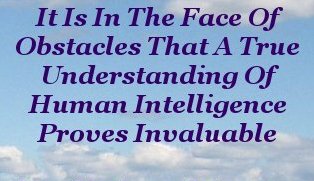
It needs to be mentioned, however, that while the idea of the Recording
Telegraph belonged to Samuel Morse, it is fair to say it was Alfred Vail
who was responsible for the development of the final working
instrument.
This final instrument did not incorporate the Samuel
Morse method of recording. Instead, the apparatus employed a means
invented by Alfred Vail.
Vail was also responsible for the Morse Code of dots and dashes.
Morse
rightly lavished praise on Gale's intellectual aid, but barely
recognized Vail's dedicated assistance and ground breaking technical
contributions. Perhaps Alfred Vail's application of Human intelligence
for the greater Good, deserves greater recognition.
Human Intelligence Rocks!
Part 18 - Part 17
Next - Technological Direction
